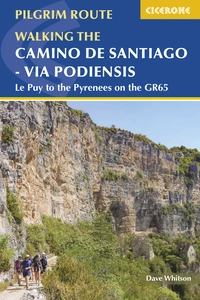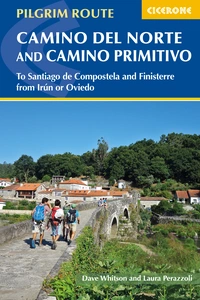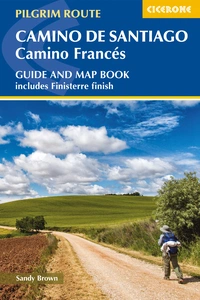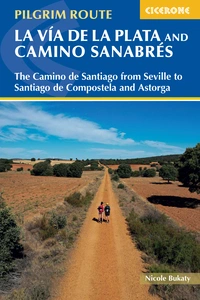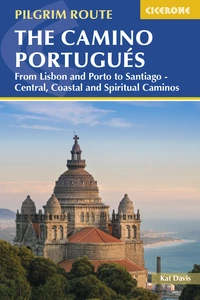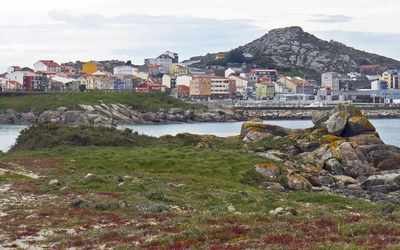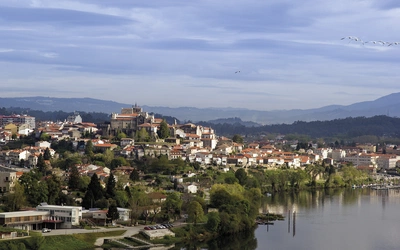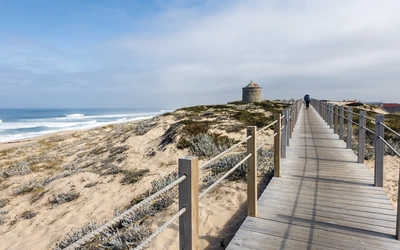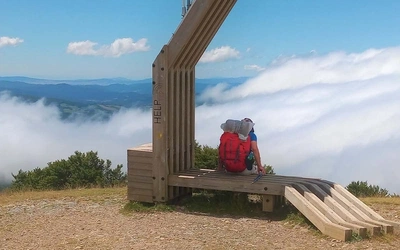Camino de Santiago experience: walking 1000 miles across France and Spain
Anna Blackwell describes spending her summer holiday walking over 1000 miles across France and Spain. Following ancient pilgrimage routes that make up the Camino de Santiago, she spent three months travelling through idyllic countryside, beautiful towns and villages and busy cities.
Collapsing onto the grass verge, my lungs bursting and legs aching, I gasped and wiped the sweat from my forehead. What was I doing? Why did I think it was a good idea to spend my summer walking 1000 miles – without even training? Why wasn’t I on the beach with my friends? And why on earth did I have the complete Lord of the Rings trilogy wedged into my already overheavy rucksack? Questions racing through my mind, I slowly raised my head. Immediately my doubts dissipated, one thought alone remaining. This was why.
An expansive view stretched out in front of me. Sun-bleached meadows rolled into tree-scattered hillsides, which dropped steeply into densely forested valleys. A church spire was visible, rising out of a small hamlet among the trees, and a few metres away from me a cow chewed lazily, tail occasionally flicking at flies.
The Way of St James
It was June and I was just over a week into my 1000-mile walk. I had chosen to spend my entire university summer holiday walking ancient pilgrimage routes from Le-Puy-en-Velay in south-central France to Finisterre in north-west Spain, following the Camino de Santiago. Fittingly, I was retracing the steps of the first foreign pilgrim to walk to Santiago de Compostela, the Bishop of Le Puy, who completed his journey in 951. It therefore seemed appropriate that my pilgrimage, while not a particularly religious venture, began with a blessing from the current Bishop of Le Puy during Pilgrims’ Mass in the impressive cathedral. Along with my blessing, I also received a pilgrim passport (créanciale) permitting me to stay in pilgrim accommodation along the way and a small pendant with St James on one side and his symbol, a shell, on the other. The final item to denote me as a pilgrim was a scallop shell to hang on the back of my rucksack.
Camino de Santiago - Via Podiensis
Le Puy to the Pyrenees on the GR65
£18.95
Guidebook to the Via Podiensis (Chemin du Puy) pilgrim route along the GR65 through southern France to the Pyrenees. The 735km route links Le Puy-en-Velay with Saint-Jean-Pied-de-Port and the start of the Camino Francés to Santiago. Includes Célé Valley and Rocamadour variants.
More informationBlessing received, I was off into the drizzle, marching down the steep, cobbled steps away from the cathedral. My journey was off to a soggy – yet beautiful – start. By day I passed through forests and farmland, climbed up gently rolling hills to marvel at idyllic pastoral scenes below. As late afternoon rolled into evening each day, I would seek out accommodation for the night. The Camino – or Chemin, in France – is fantastically well supported and pilgrims and walkers can find plenty of places to sleep. I often stayed in small, basic dormitories and shared my evening meal with other walkers. Dinner tended to be local fare and, while delicious, this did mean I ate Puy lentils and sausage every day for the first week or so!
I soon began to notice a recurring theme. The gentle, smooth footpaths had given way to steep and rocky tracks that wound their way up through ancient woods. Emerging at the top, you were rewarded with a spectacular view. This would always make me smile to myself; I spent the majority of the ascents cursing the drastic incline, but reaching the summit, I would always have to acknowledge that the climb was worth it for the view. Dispersed through the countryside were quaint towns that felt like they may not have changed in centuries. Following the River Lot, these towns cropped up daily and I couldn’t stop myself from pausing to explore the cobbled streets and medieval buildings. In cities such as Saint-Côme d’Olt, Espalion and Estaing, there are chateaus and churches that date back to the 14th and 15th centuries, steeples and spires visible over the wood-beamed buildings.
Nowhere is this history more evident than the hillside town of Conques. Descending through the tree-lined valley, I caught occasional glimpses of elaborately tiled rooftops peeking out below. It wasn’t until the footpath met the narrow, cobbled road at the entrance to the town that I saw where I was. Conques is so well preserved that I felt like I was walking through the set of a fairytale film. The medieval streets are too narrow and winding for cars and buses to drive through, and the consequent pedestrianisation has the effect of transporting you back in time. Reaching the 11th-century cathedral, this feeling only increased: tethered in the shade was a donkey, waiting patiently for his owner to return.
In these towns I often met wonderful people who added an extra layer of enjoyment to what was otherwise a solitary experience. Sitting on the steps of the 15th-century chateau in Estaing, I was approached by a couple. It quickly transpired that Basil and Francis were also English, with children roughly my age. After a delightful conversation, I bid them farewell and made my way down to the riverside to eat my rather pitiful lunch of slightly stale bread, sweaty cheese and a squashed tomato. I’d barely taken my first mouthful when Basil and Francis reappeared, bearing armfuls of fresh food and chilled drinks. Piling the goods next to me, they insisted that I took as much as I could carry. I beamed up at them both, lost for words and overcome with gratitude at their kindness.
As the number of miles behind me increased, so too did the daily temperatures as I walked through a record-breaking heatwave in France. To mitigate for the inevitable afternoon heat, I began waking up before dawn and would be back on the move an hour before sunrise. By lunchtime it was exceeding 36˚°C, an unbearable temperature to be walking in, and I often found myself seeking shade by the side of the path wherever possible. It was with a sense of relief that, in lowering temperatures, I approached the Pyrenees. The mountains signified the end of my 500-mile section through France and the completion of the Chemin du Puy. Ahead lay Spain and the immensely more popular Camino del Norte, the path I was to follow along the north coast.
Arriving into Saint-Jean-Pied-de-Port and passing under the Porte St-Jacques, I felt emotional at having successfully reached my halfway point. The month it had taken me to reach this point had been eventful but equally a huge learning curve for me, and I felt ready to take on the Camino in Spain.
The Spanish portion: Camino del Norte and Primitivo
My plan from Saint-Jean-Pied-de-Port had been to walk through the Pyrenees to Irun on the Spanish coast, where I would join the Camino del Norte. However, after two days in the mountains, huge storms rolled in. Instead of sitting around and losing momentum, I decided to catch a series of buses and trains to the start of the Camino del Norte instead. In Irun, I was joined by a group of fresh-faced, excited pilgrims setting out on their first Camino. It felt strange to now be around so many people after so much time alone in France, but I welcomed the new social side of my adventure. I was glad to have already covered a significant distance and strengthened my legs, for the coastal route of the Camino is a rollercoaster of ascent and descent. On one day, the total ascent was the equivalent of Ben Nevis, the following day, it was Scafell Pike… The route repeatedly goes from sandy beach to clifftop vista, making for challenging but spectacularly beautiful walking.
The Camino del Norte and Camino Primitivo
To Santiago de Compostela and Finisterre from Irun or Oviedo
£18.95
Guidebook to walking the Camino del Norte and Camino Primitivo pilgrim routes to Santiago de Compostela in northwest Spain. The 820km Camino del Norte from Irún via Bilbao and Santander takes around 5 weeks to complete. The 355km Camino Primitivo takes about 2 weeks. Includes the Camino Finisterre from Santiago to the coast.
More informationA downside to now sharing the way with so many other people was the tougher competition over the best beds in each albergue (pilgrim hostel). Gone were the days of having a whole dormitory to myself as I often did in France. On my second night on the Norte I had a rude awakening to the reality of my new pilgrim life, as I essentially shared a bed with an overweight, hairy-backed, snoring, farting Spanish man. To top it all off, he slept in his tighty-whiteys! Some of my other somewhat unusual sleeping arrangements included dormitories of over 120 people, a mattress on the kitchen floor, and even a small marquee in the garden of one of the albergues. Here, I discovered just how little time it takes for a hysterical giggle fit to spread around 13 people crammed into a tiny tent…
After a few weeks of following coastal footpaths and crisscrossing big cities like Bilbao and Santander, the option arose to deviate inland to join the Camino Primitivo, a 190-mile branch of the Camino crossing the mountains. Because of the more challenging terrain and its relative remoteness, the Primitivo is generally considered the toughest of the Caminos. This, for me, is what made the Primitivo so appealing. It immediately felt more wild and rugged, with fewer walkers and villages along the way. A few days in, we faced what is known as the Hospitales Route: a 990m ascent through the mountains, past the ruins of three pilgrim hospitals before an 800m descent into a small village.
Setting out at dawn, I was immediately surrounded by wispy, white cloud. I persevered through it and after a short while of continuous climbing, popped out above the cloud. Cresting the hillside, I could see seemingly endless layers of hazy mountains fading into the horizon, a vivid blue sky reaching overhead. The incredible weather and scenery meant that this turned out to be one of the most rewarding days of the whole three months of walking.
Coming down from the mountains, I endured a few days of constant rain before reaching the Roman walled city of Lugo. Lugo is famous not only for its UNESCO World Heritage Site walls, but also for its 2nd-century baths (still open as a spa) and I wasted no time in immersing myself in the medicinal water, allowing the minerals to work their magic on my tired body. With just 65 miles left until Santiago, I joined the Camino Frances. This is the most popular route with pilgrims, particularly this last stretch from Sarria to Santiago that I was now on, as it is the minimum distance required to walk to be granted a certificate of your pilgrimage. It was far busier than any of the other routes I’d completed, but the buzz and sense of excitement in the air made up for the relative crowds.
Finally, just fewer than 1000 miles, I reached Santiago de Compostela. Standing in front of the scaffolding-clad cathedral, surrounded by jubilant pilgrims, I reflected that I wasn’t ready to finish my journey. Luckily for me, this was not the end of my pilgrimage: I still had four days and some 55 miles to cover as I continued from Santiago to Finisterre at the Atlantic coast.
Camino de Santiago: Camino Frances
Guide and map book - includes Finisterre finish
£17.95
Guidebook and map book to walking the 784km Camino Frances from St Jean-Pied-de-Port in southern France to Santiago de Compostela in Spain, including an additional route to Finisterre. Split into 6 sections and 36 customisable stages, the guide lists over 500 pilgrim hostels. The map book covers the entire route, which can be walked in 4-5 weeks.
More informationFinisterre Extension
Before leaving Santiago, I attended pilgrim mass at the cathedral and watched the botofumeiro, a 5ft tall incense burner. Weighing 80kg, it is suspended from a rope pulley mechanism and swung in a 65-metre arc over the congregation. It is truly a sight to behold.
My final four days of walking were completed in either rain or cloud, reflecting how I felt about concluding my adventure. However, the weather didn’t deter from my appreciation of my surroundings. Instead it was very atmospheric and beautiful; the moisture in the air clung to leaves and occasional partings in the cloud revealed snippets of a stormy Atlantic. By coincidence, the day I reached Finisterre also happened to be my 22nd birthday. Taking my final steps through the thick fog to the lighthouse atop the cliffs, I felt such an incredibly confusing mix of emotions: pride at having walked 1000 miles and happy that it was my birthday and I would soon be reunited with friends and family who I hadn’t seen in months. I also felt an odd sense of dread at the prospect of returning to ‘normal life’ and immense disappointment that my journey had ended.
The last 11 weeks of walking had been life-altering. I had walked through so many beautiful corners of France and Spain and received incredible amounts of kindness and generosity from complete strangers. Those months had taught me that I was so much stronger than I thought, physically and mentally, but they had also led me to realise that I had a true sense of passion and curiosity when it came to the world of adventure, something I knew deep down would form the basis of many wonderful future journeys.

